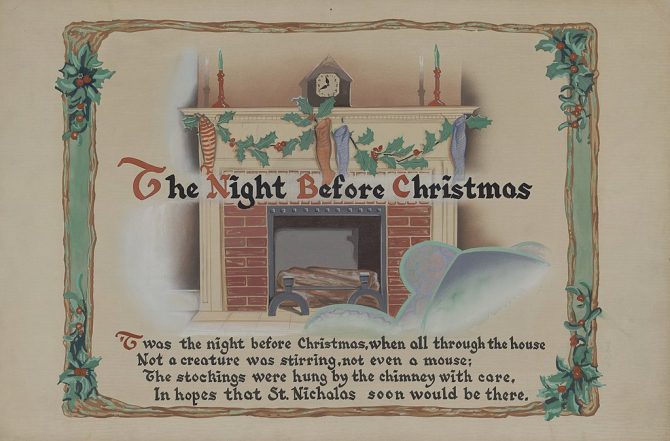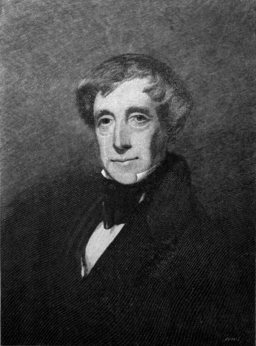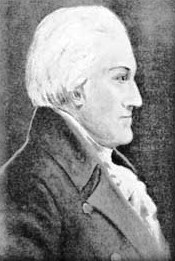“'Twas the night before Christmas, when all thro' the house,
Not a creature was stirring, not even a mouse…”
So opens “A Visit from St. Nicholas,” more commonly known as “The Night Before Christmas” and “'Twas the Night Before Christmas.” The poem was first published anonymously on December 23, 1823, in the Troy Sentinel newspaper in Troy, New York, and has since become a holiday classic that is often credited as introducing the idea of Santa’s reindeer and establishing Santa Claus as a jolly, gift-giving elf.
Given this, it’s common for people to ask who wrote the poem, and debating the authorship of “A Visit from St. Nicholas” has become part of its legacy and the annual Christmas celebrations. There are two people who have a claim to being the author: Clement Clarke Moore and Henry Livingston, Jr.
Clement Clarke Moore
Born in 1779 into a prominent New York family—his father, Episcopal bishop Benjamin Moore, administered last rites to Alexander Hamilton after he was mortally wounded in his duel with Aaron Burr—Clement Moore was himself a professor of Oriental and Greek literature at the General Theological Seminary in Manhattan.
Those who hold that Moore wrote “The Night Before Christmas” point to the poem long being attributed to him, beginning in 1829 when the editor of the Troy Sentinel alluded to Moore as the author. This was followed by a string of reprintings by others also listing Moore as the author. Moore finally published an edition of the poem under his name in 1844. This attribution is often accompanied by a separate tradition holding that Moore wrote the poem after returning home from a winter shopping trip, dashing it off in a couple of hours before reading it to his children, who all would later claim the poem was his as well.
Henry Livingson, Jr.
Henry Livingston, Jr. was also from a prominent New York family—Henry’s cousin administered George Washington’s Presidential Oath of Office—with Henry himself being a major in the Revolutionary War before becoming a surveyor, farmer, and poet (though he only wrote anonymously).
Those who hold that Livingston is the originator point to numerous factors. First, they note that while Livingston never claimed authorship publicly—in fact, family members didn’t learn until almost 20 years after Livingston had died that Moore had laid a claim—members of the Livingston family could recall hearing Henry recite it as early as 1807, and the family had an original paper version, though it was said to be lost in a house fire in 1828. Henry’s descendants made many attempts to correct what they viewed as the theft of their father’s poem, with the first formal claim being made in 1899 and claims being made again roughly every 20 years since.
Those who argue for Livingston also cite the work of professors Don Foster and MacDonald P. Jackson. Mary Van Deusen, Livingston's 5th great-granddaughter, approached Vassar professor Foster with the Livingston family's authorship arguments. He agreed to conduct a literary forensic analysis of the poem using data Van Deusen collected from libraries around the country. His conclusion, after comparing the style, meter, word choice, and imagery of the Christmas poem with the known bodies of work by Livingston and Moore, was that it aligned with Livingston.
Jackson, an emeritus professor in New Zealand and one of the major authorities on Shakespeare and authorship attribution, felt that a more effective technique to uncovering the actual authorship was to statistically analyze those same bodies of work. He applied to Van Deusen to provide him with data. The most traditional way of doing this objectively was to look at use and frequency of unconscious writing characteristics, such as the rate of small words like "a," "and," and "the." Van Deusen brought into the research an expert in computational linguistics, Lyn Bates, who suggested an additional objective approach which hadn't been used in authorship attribution—the use of paired phonemes, the last sound of one word followed by the first sound of the following word. Since this effectively examines the movement of the tongue in the mouth, it explained why the poetry of Livingston flowed more smoothly than that of Moore when spoken aloud.
In 2016, Jackson wrote in his work "Who Wrote 'The Night Before Christmas'?: Analyzing the Clement Clarke Moore Vs. Henry Livingston Question: that, so far, every test his team conducted indicated that Livingston's work matched statistically with that of the poet of "The Night Before Christmas," while Moore's work was outside the statistical range identified in the poem. Objective statistical analysis pointed to Livingston as the Christmas poem's author.
Nevertheless, the heated debate continues to this day. In addition to academic researchers, the general public has also joined in, with mock trials being held in Troy in 2013 and 2014, with one trial ending in a hung jury while the other held for Livingston. The trials themselves have also been dramatized. Hallmark used them as the inspiration for their 2022 Christmas film, The Trial Before Christmas.
You can read and learn more about “A Visit from St. Nicholas,” the authorship debate, the trials, and see the evidence yourself at the links below. And, regardless of who you come to think wrote the poem, we at the library join in the poem’s ending wish: a “Happy Christmas to all, and to all a good night.”
Note: The writer would like to thank Mary Van Deusen for her assistance in the creation of this post.
Resource List:
"America's most well-known poem made first appearance in Troy newspaper in 1823", opens a new window (Times-Union)
Henry Livingston, Jr., the Author of "The Night Before Christmas", opens a new window
A Smoking Gun? You Decide!, opens a new window
Troy Sentinel, Broadside, opens a new window, designed by Myron King. Printed by N. Tuttle, ca. 1830
LIVINGSTON v. MOORE: Who really wrote “A Visit from Saint Nicholas”?, opens a new window
Today in History - December 24: Time for a Visit from St. Nicholas, opens a new window (Library of Congress
The Troy Sentinel, 23 December 1823, opens a new window
Who invented Santa Claus? Who really wrote the “Night Before Christmas?”, opens a new window
"Who REALLY wrote The Night Before Christmas? A linguistic analysis", opens a new window (History Cooperative)
Editor's note: Central Rappahannock Regional Library owns many editions and variations, opens a new window of "The Night Before Christmas." Readers can find it in print, opens a new window format, as an eBook,, opens a new window on audio CD,, opens a new window as a read-along, opens a new window, on DVD,, opens a new window as a streaming video, opens a new window for children, and in braille., opens a new window It is truly a classic. All that use the original words are officially credited to Clement Clarke Moore. For more information on American Christmas traditions in earlier centuries, check out Christmas in America, opens a new window and God Rest Ye Merry, Soldiers: A True Civil War Christmas Story., opens a new window





